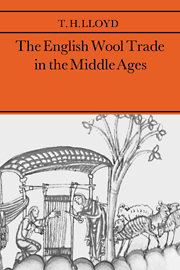Book contents
- Frontmatter
- Contents
- List of Tables and Maps
- Preface
- Abbreviations used in Notes and Bibliography
- 1 The growth of the Flemish connection
- 2 The end of the Flemish ascendancy
- 3 The Italian hegemony
- 4 The English triumphant
- 5 Edward III – woolmonger extraordinary
- 6 Quest for a staple policy
- 7 The evolution of the Calais staple
- 8 The decline of the wool trade
- 9 Marketing the wool
- Notes
- Bibliography
- Index
7 - The evolution of the Calais staple
Published online by Cambridge University Press: 10 December 2009
- Frontmatter
- Contents
- List of Tables and Maps
- Preface
- Abbreviations used in Notes and Bibliography
- 1 The growth of the Flemish connection
- 2 The end of the Flemish ascendancy
- 3 The Italian hegemony
- 4 The English triumphant
- 5 Edward III – woolmonger extraordinary
- 6 Quest for a staple policy
- 7 The evolution of the Calais staple
- 8 The decline of the wool trade
- 9 Marketing the wool
- Notes
- Bibliography
- Index
Summary
The return of the staple to Calais at the command of the Good Parliament in 1376 did nothing to halt the decline of the English wool trade. The fall in exports which had begun in the 1360s continued unabated throughout the last quarter of the fourteenth century. In the search for an explanation of this decline particular attention must be given to three matters of policy, namely the staple, the taxation of exports and monetary regulation. Before examining each of these, however, one must recognise the importance of events over which the English had little or no control. Civil strife in Flanders and Florence had damaging effects on the cloth manufacturing industries of each of these regions and led, in turn, to a reduction in the demand for English wool.
The civil war which racked Flanders from 1379 to 1385 has been described as a ‘total disaster’ and the opinion advanced that ‘it is questionable whether the Flemish economy recovered from this conflict before the modern period’. The material damage was probably greater than that caused at any time since the struggle with France in the early fourteenth century. The English were themselves partly responsible for this, with the suburbs of Ypres being destroyed in the siege of 1383. The experience of these years probably accelerated the movement of the Flemish cloth industry from the towns to rural areas. This encouraged the use of cheaper native, Scots and Spanish wool at the expense of the English product.
- Type
- Chapter
- Information
- The English Wool Trade in the Middle Ages , pp. 225 - 256Publisher: Cambridge University PressPrint publication year: 1977



